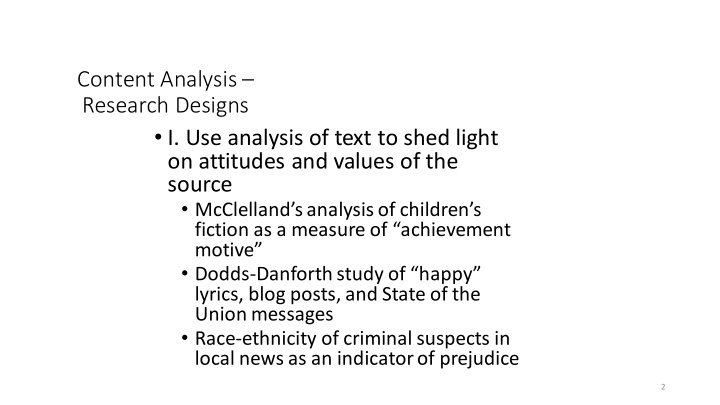



Content Analysis – Research Designs • I. Use analysis of text to shed light on attitudes and values of the source • McClelland’s analysis of children’s fiction as a measure of “achievement motive” • Dodds- Danforth study of “happy” lyrics, blog posts, and State of the Union messages • Race-ethnicity of criminal suspects in local news as an indicator of prejudice 2
• II. Using content of news reports messages to assess causes of news programming, e.g. importance of market forces • Comparing public broadcasters and commercial broadcasters for extent of hard-soft and international-domestic coverage • Comparative analysis of niche versus generalist sources (e.g. Wall St Journal vs. NYT) • Partisan vs non-partisan sources 3
• III. Examining content to make inferences about effects of messages on behavior • Suicide notes • Diplomatic cables and onset of war • Candidate rhetoric and vote share • Infotainment and market share 4
Stages of Content Analysis • (1) Identify relevant sources, identify the population of messages (op eds vs news; front- page news, etc., and draw a sample) • (2) Develop content categories • Categories guided by theoretical-conceptual considerations (e.g. market forces make news organizations over-produce soft news; campaign news dwells on “horse race” and strategy at the expense of policy) 5
Coding Scheme • Content categories to reflect underlying concept – soft news, objective news, news as negative (bad versus good news), reliance on official sources, etc etc. • Categories should be exhaustive and mutually exclusive • Categorization process to be independent, i.e. categorization of any given message should not depend on categorization of previous message 6
• Intro – statement of the problem, why this is relevant/important; Table of Contents theory and hypothesis • Outline your research design/strategy – sample of news sources, coding scheme, inter- coder reliability • Presentation and interpretation of results • Discussion-Implications 7
Unit of Analysis and Reliability • What gets coded – words, sentences, paragraphs, entire news report • holistic coding; roles played by men and women in advertisements; treatment of minorities in entertainment programs • Issue of inter-coder reliability; have multiple coders categorize the same messages 8
Presentation of Results • Tabulate results of coding – word counts, percentages, column inches • Interpret results in terms of theoretical expectations 9
Online Databases Lexis-Nexis includes >500 daily newspapers, magazines, Blogs, and some transcripts of TV programs http://lib.stanford.edu/lexis-nexis-academic 10
Recommend
More recommend